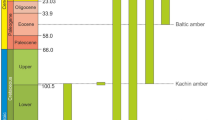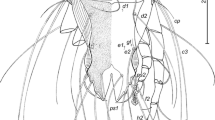Abstract
Structures of the wings, legs and abdomen of three new species of Jurassic ‘Orthophlebiidae’ from Karatau in Kazachstan (Orthophlebia elenae, O. heidemariae, O. longicauda) are described in detail. On their hind legs, the males of two of the species have a so-called metatarsal organ of unknown function, which certainly is a synapomorphy.Orthophlebia longicauda is very similar to the Tertiary speciesHolcorpa maculosa, as they both possess a fork consisting of two long processes arising from the hind margin of abdominal segment 6 as well as an elongate abdomen. A female specimen ofO. elenae shows, in its 9th abdominal segment, the medigynium, a genital structure of major importance for reconstructing the phylogenetic position of Mecoptera. As in the Panorpodidae andHolcorpa, the medigynium ofO. elenae does not bear two tongue-shaped processes which are characteristic of the Panorpidae. This is the first time that female genitalia are described from a Mesozoic mecopteran species. The males of the three new species show the tergites and sternites of abdominal segments 6 to 8 to be unfused or incompletely fused, as the sclerites’ margins are still visible. This implies that contrary to earlier assumptions, completely fused sclerites in segment 8 leaving no trace of their delimitations are not a synapomorphy of the Panorpomorpha (= Eomeropidae,Apteropanorpa, Choristidae,Choristopanorpa and ‘Orthophlebiidae’ plus descendants).
Zusammenfassung
Die Morphologie von drei neuen Arten der ‘Orthophlebiidae’ aus dem Jura von Karatau in Kasachstan (Orthophlebia elenae, O. heidemariae, O. longicauda) wird eingehend beschrieben. Zwei dieser Arten weisen im Metatarsalorgan der Hinterbeine eine Synapomorphie auf. Die mögliche Funktion der Metatarsalorgane wird diskutiert.Orthophlebia longicauda ähnelt in Fortsätzen am 6. Abdominalsegment und dem stark verlängerten Abdomen sehr der tertiärenHolcorpa maculosa. Bei einem Weibchen vonO. elenae lassen sich im Abdomen mit dem Medigynium für die Bestimmung der Verwandtschaftsbeziehungen wichtige Genitalstrukturen erkennen. Es besitzt, wie die Panorpodidae, keine zungenförmigen Fortsätze. Damit werden zum ersten Mal die weiblichen Genitalien mesozoischer Mecopteren genauer beschrieben. Da bei den Männchen aller drei Arten die Tergite und Sternite der Abdominalsegmente 6 bis 8 noch die Grenzen zueinander erkennen lassen, war die Fusion zu einem einheitlichen röhrenförmigen Sklerit noch nicht oder noch nicht vollständig vollzogen. Damit ist eine vollkommene Fusion von Tergit und Sternit 8 entgegen den bisherigen Auffassungen keine Synapomorphie der Panorpomorpha (= Eomeropidae,Apteropanorpa, Choristidae,Choristopanorpa und ‘Orthophlebiidae’ mit Nachkommen).
Similar content being viewed by others
Literatur
Carpenter, F. 1931. The affinities ofHolcorpa maculosa Scudder and other Tertiary Mecoptera, with descriptions of new genera. - Journal of the New York Entomological Society39: 405–414, New York.
Jell, P. &Duncan, P. 1986. Invertebrates, mainly insects, from the freshwater, Lower Cretaceous, Koonwarra Fossil Bed (Korumburra Group), South Gippsland, Victoria. - Memoirs of the Association of Australasian Palaeontologists3: 111–205, Sydney.
Martynov, A. 1927. Jurassic fossil Mecoptera and Paratrichoptera from Turkestan and Ust-Balei (Siberia). - Bulletin de l’Académie des Sciences de l’URSS1927: 651–666, Moskau.
Mickoleit, G. 1971. Zur phylogenetischen und funktionellen Bedeutung der sogenannten Notalorgane der Mecoptera (Insecta, Mecoptera). - Zeitschrift für Morphologie der Tiere69: 1–8, Berlin.
Novokschonov, V. 1996. Tainstvennye organy samzov jurskich scorpionniz Orthophlebiidae (Insecta, Mecoptera) iz Karatau. -Zoologitscheskij zhurnal75 (10): 1491–1495, Moskau.
Rohdendorf, B.B. &Rasnitsyn, A.P. (ed.) 1980. Istoritscheskoje rasvitije klassa nassekomych. - Trudy paleontologicheskogo Instituta Akademia Nauk SSSR175: 1–256, Leningrad.
Rautian, A. 1978. A unique bird feather from Jurassic lake deposits in the Karatau. - Paleontological Journal1978: 520 -528 [russ.: Paleontologicheskii Zhurnal 1978: 106–114], Moskau.
Willmann, R. 1978. Mecoptera (Insecta, Holometabola). - Fossilium Catalogus. Animalia124: 1–139. The Hague (W.Junk).
— 1981. Das Exoskelett der männlichen Genitalien der Mecoptera (Insecta). I. Morphologie. II. Die phylogenetischen Beziehungen der Schnabelfliegen-Familien. - Zeitschrift für zoologische Systematik und Evolutionsforschung19: 96–150, 153–174, Hamburg, Berlin.
— 1989. Evolution und phylogenetisches System der Mecoptera (Insecta, Holometabola). - Abhandlungen der Senckenbergischen naturforschenden Gesellschaft544: 1–153, Frankfurt/M.
Author information
Authors and Affiliations
Rights and permissions
About this article
Cite this article
Willmann, R., Novokschonov, V. Neue Mecopteren aus dem oberen Jura von Karatau (Kasachstan) (Insecta, Mecoptera: ‘Orthophlebiidae’). Paläontol Z 72, 281–297 (1998). https://doi.org/10.1007/BF02988359
Received:
Accepted:
Issue Date:
DOI: https://doi.org/10.1007/BF02988359




